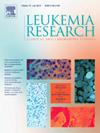HDAC抑制剂抑制runx1 - mecom型白血病细胞中Tek和Angpt1的表达和增殖
IF 2.1
4区 医学
Q3 HEMATOLOGY
引用次数: 0
摘要
t(3;21)(q26;q22)易位产生的RUNX1-MECOM融合基因是急性巨核细胞白血病的致病基因,其产生的产物通过募集组蛋白去乙酰化酶(HDAC)发挥多种分子功能。我们之前通过逆转录病毒转导RUNX1-MECOM建立了小鼠骨髓移植模型。该模型表明,表达runx1 - mecom的细胞可发生急性巨核母细胞白血病,并可连续移植。通过定量RT-PCR分析,发现白血病细胞中Angpt1(血管生成素1)和Tek转录物升高。在本研究中,我们证实了Angpt1和Tek蛋白在runx1 - mecom表达细胞中同时表达。当外源性Angpt1刺激原代白血病细胞时,内源性Tek被磷酸化,随后下游Akt被磷酸化。Angpt1和Tek可能形成自分泌回路,提高白血病细胞存活率。有趣的是,Tek和Angpt1的表达被HDAC抑制剂(HDACi)、曲古霉素A (TSA)和丙戊酸(VPA)下调。因此,HDACi可能阻断Angpt1和Tek自分泌回路。TSA和VPA均通过诱导细胞周期阻滞和凋亡抑制体外表达runx1 - mecom细胞的生长。电镜分析进一步表明,HDACi处理可诱导部分巨核细胞分化。此外,腹腔注射VPA,而不是TSA,延长了二次移植小鼠的存活时间。这些数据证明了hdac作为runx1 - mecom型白血病的靶向治疗的潜力。本文章由计算机程序翻译,如有差异,请以英文原文为准。
HDAC inhibitors repress Tek and Angpt1 expression and proliferation in RUNX1-MECOM-type leukemia cells
The RUNX1-MECOM fusion gene generated by the t(3;21)(q26;q22) translocation is a causative gene of acute megakaryoblastic leukemia, and the generated product performs various molecular functions by recruiting histone deacetylase (HDAC). We had previously established a mouse bone marrow transplantation model through the retroviral transduction of RUNX1-MECOM. This model demonstrated that RUNX1-MECOM-expressing cells developed acute megakaryoblastic leukemia and were serially transplantable. Gene expression analyses using quantitative RT-PCR arrays revealed that Angpt1 (Angiopoietin 1) and Tek transcripts were elevated in the leukemic cells. In this study, we confirmed the concomitant expression of Angpt1 and Tek proteins in the RUNX1-MECOM-expressing cells. When the primary leukemic cells were stimulated with exogenous Angpt1, endogenous Tek was phosphorylated, followed by the phosphorylation of downstream Akt. Angpt1 and Tek may form a circuit of an autocrine loop and enhance leukemia cell survival. Interestingly, the expression of Tek and Angpt1 was downregulated by HDAC inhibitors (HDACi), trichostatin A (TSA) and valproic acid (VPA). Therefore, HDACi may block the Angpt1 and Tek autocrine loop. Both TSA and VPA inhibited the growth of RUNX1-MECOM-expressing cells in vitro by inducing cell cycle arrest and apoptosis. Electron microscopic analysis further indicated that partial megakaryocytic differentiation was induced after HDACi treatment. Furthermore, intraperitoneal injection with VPA, but not TSA, extended the survival of the secondary transplanted mice. These data demonstrate the potential of HDACi as a promising targeted treatment for RUNX1-MECOM-type leukemia.
求助全文
通过发布文献求助,成功后即可免费获取论文全文。
去求助
来源期刊

Leukemia research
医学-血液学
CiteScore
4.00
自引率
3.70%
发文量
259
审稿时长
1 months
期刊介绍:
Leukemia Research an international journal which brings comprehensive and current information to all health care professionals involved in basic and applied clinical research in hematological malignancies. The editors encourage the submission of articles relevant to hematological malignancies. The Journal scope includes reporting studies of cellular and molecular biology, genetics, immunology, epidemiology, clinical evaluation, and therapy of these diseases.
 求助内容:
求助内容: 应助结果提醒方式:
应助结果提醒方式:


